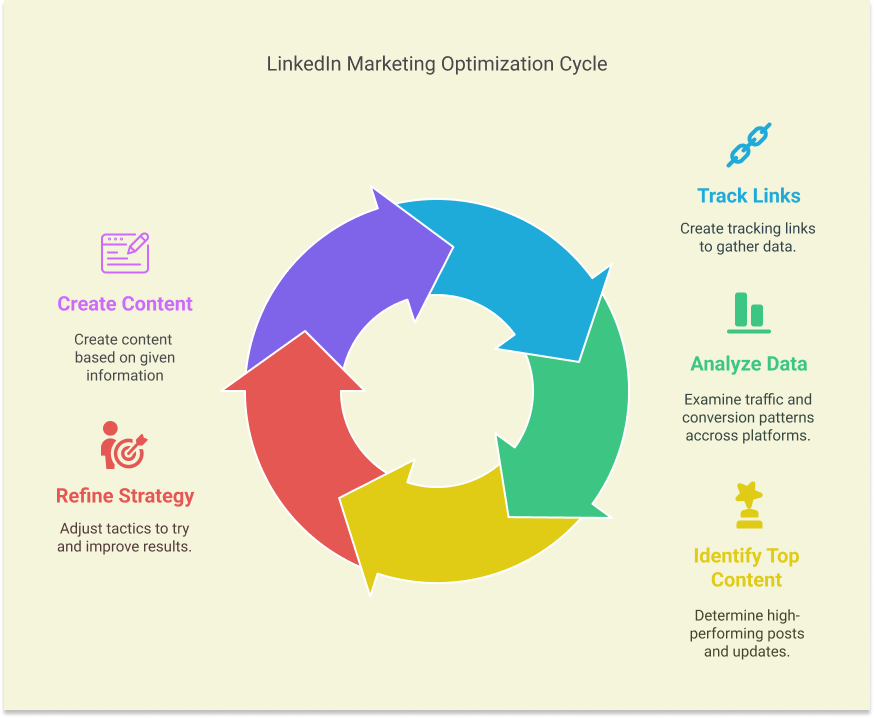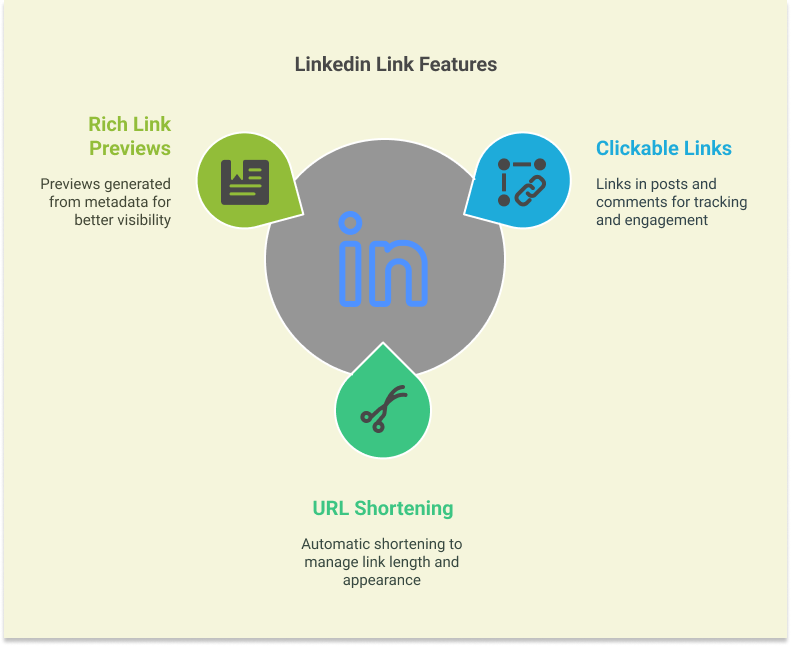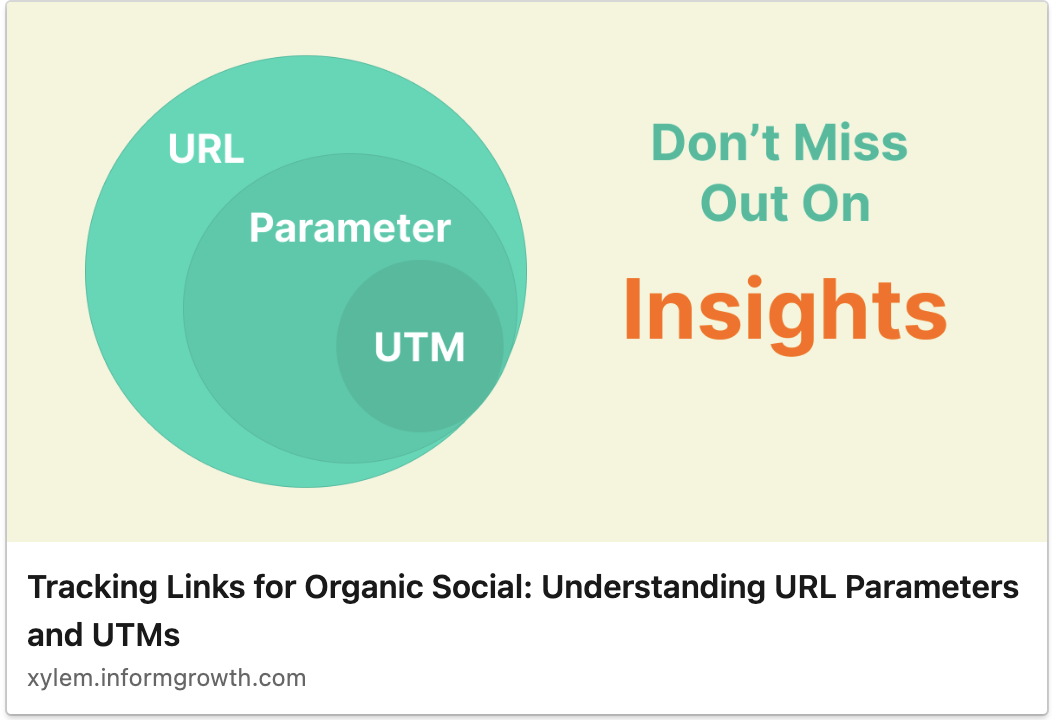If you're actively sharing content on LinkedIn without properly tracked links, you’re leaving critical insights—and potential revenue—on the table. You might see likes and comments, but do you truly know what’s driving actual conversions? Proper link tracking lets you optimize your content and is your key to transforming LinkedIn engagement into measurable business success.
Why Link Tracking Matters on LinkedIn
Tracking the links you share on LinkedIn, helps you see how your audience moves from LinkedIn to your website. These deeper insights show which posts, comments, profile updates or direct messages actually lead to sign-ups, downloads, or sales. By knowing what truly drives traffic and conversions, you create a flywheel affect that lets you optimize and pivot your content to continually improve. This process works as follows:
- Create Content: Start with what you think is best—create content in different formats and topics. Write down your hypotheses and why you think this content should work to drive the metrics on your website.
- Track Links: Create tracking links for your content that let you identify users who click on that link and post your content.
- Analyze Data: See how engaged people are with the content in LinkedIn and track how that engagement converts to the action you want people to take on your website.
- Identify Top Content: Based on your analysis, find what content works best and what content flopped.
- Refine Strategy: Go back to your assumptions about why you thought certain content would perform better, and update your strategy based on what worked.
Repeat forever and never stop experimenting.

LinkedIn Link Sharing Features
LinkedIn has unique features that you can take advantage of when sharing links:
1. Clickable Links in Posts and Comments
- LinkedIn supports clickable links within both posts and comments, providing opportunities for additional tracking points.
- Strategic placement of different tracked links in comments can extend reach and capture different engagement patterns.
2. Automatic URL Shortening
-
LinkedIn automatically shortens URLs longer than 26 characters using the domain
lnkd.in. - Automatic shortening only happens in posts, not comments or direct messages.
- Shortened URLs obscure UTMs but also your domain, meaning your branded domain is not visible.
3. Rich Link Previews
- LinkedIn reads metadata from your website and creates a preview card with a title, description, and image.
- Use LinkedIn’s Post Inspector Tool to verify your preview and correct any issues with how your link appears.
- LinkedIn generates rich preview cards from your URL's metadata through Open Graph Protocol metadata tags placed in your site’s headers.

Why Open Graph Protocol Matters
The Open Graph Protocol (OGP) helps LinkedIn (and other platforms) display attractive link previews. When your page has correct OGP tags—such as
og:title, og:description, og:url, and og:image—LinkedIn can pull in the right information for:
- Posts – When you share a link in a post, the platform automatically grabs the OGP data for a preview.
- Comments – A link posted in comments also displays OGP data.
- Direct Messages – Sending a link through LinkedIn messages shows the same rich preview.
- Job Descriptions – If you add a link to a job listing or update, LinkedIn will try to display a preview there as well.
Without proper OGP tags, your content might show up with a weak or blank preview, which can reduce clicks. As an example, below is the Open Graph protocol markup for the previous blog post, “Tracking Links for Organic Social: Understanding URL Parameters and UTMs”.
<head>
<meta property="og:title" content="Tracking Links for Organic Social: Understanding URL Parameters and UTMs">
<meta property="og:type" content="article">
<meta property="og:url" content="https://xylem.informgrowth.com/blog/tracking_links_for_organic_social">
<meta property="og:image" content="https://uyviwwtnmvanfnqftckv.supabase.co/storage/v1/object/public/blog_assets//trackin_link_header.png">
<meta property="og:description" content="Discover how tracking links using URL parameters and UTMs empower you to monitor your digital marketing campaigns and gain valuable insights into your online traffic...">
...
</head>
This results in the following preview being displayed:

Step-by-Step Checklist for Sharing Links on LinkedIn
-
Check Your Open Graph Tags:
- Make sure your webpage has the right OGP tags.
- Use LinkedIn’s Post Inspector Tool to verify the preview.
-
Decide Where to Share the Link and Come Up with Content:
- Will you share the link in a post, a comment, your profile’s “Featured” section, a job update, or in direct messages?
- Tailor your message for each channel. For example, a casual tone might work in direct messages, while a more structured summary is better in posts.
-
Add UTM Parameters:
- Append UTMs to distinguish traffic from each channel (Use
utm_contentto specify link placement). - Keep naming consistent so you can easily spot which channel works best in your analytics.
-
An example for a LinkedIn post:
utm_source=linkedinutm_medium=socialutm_campaign=product_launchutm_content=post1
- Tip: Use a UTM tool like Xylem to ensure conventions are kept consistent.
- Append UTMs to distinguish traffic from each channel (Use
-
Share and Monitor:
- Paste your link, confirm the preview looks correct, and add a short call-to-action (“Check it out,” “Read more,” etc.).
- Watch your analytics (e.g., Google Analytics) to see how many clicks, leads, or conversions come from each tracked link.
5. Experimenting With Link Placement Across Posts, Comments, Profiles, and Job Updates
Experimenting with different placements and tracking the results is how you gain insight into what truly connects with your audience. Each experiment helps you tie back to the three key reasons for tracking links: pinpointing what performs best, understanding engagement patterns, and refining your approach to boost ROI.
- Main Post vs. First Comment: Share the same URL in different spots. See which one gets more clicks, engagement, or conversions.
- Multiple CTAs: Place a link in the main post and a different tracked link in the comments (or your profile). Compare traffic data.
- Profile Featured Section: Promote an important blog post or landing page in your Featured section. Also share it in a regular post. Track which one brings more visitors or sign-ups.
- Job Update Announcements: When you change your job title or post a new opening, include a relevant link (e.g., a product page or press release). Note how many visits come from that link.
- Rotating “About” Section Links: Swap out the link in your About section occasionally to highlight a fresh offer or piece of content. Track which version drives more clicks or leads.
Analyzing Your Results
After each test, look at the data in your analytics tool:
- Which channel or placement got the most clicks or sign-ups?
- What topics or angles attracted the highest-quality leads?
- Did certain previews (titles, descriptions, images) inspire more engagement?
Tools to Simplify LinkedIn Tracking
Creating and managing UTM links doesn’t need to be complicated. Consider these tools:
- Xylem: Ensures consistency, facilitates collaboration, and generates QR codes.
- Google Campaign URL Builder: Simple tool for creating one-time links.
- Spreadsheets or Notion: Flexible but manual and error-prone.
Implement Today, See Results Tomorrow
Effective tracking links are essential to LinkedIn marketing success. Begin applying these best practices immediately and transform your LinkedIn efforts into measurable, data-driven insights.